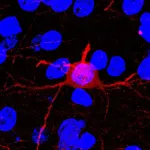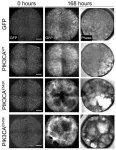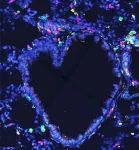(Press-News.org) Ancient climates can help us understand the past, but also the future. 23 million years ago, in a time called the Miocene Epoch, Connecticut was around five to six degrees warmer than today and located roughly where Long Island is now. By the end of the Miocene, around five million years ago the earth had gradually cooled, Antarctica was glaciated, and there was some Arctic ice as well.
This cooling scenario moved in the opposite direction of today’s changing climate. One difference UConn Department of Earth Sciences Assistant Professor in Residence Tammo Reichgelt points out is that in the past, these changes happened gradually, spaced out over 18 million years rather than over just a few hundred years like with the current pace of global warming. The Miocene may still give us insight into what is in store for us in a warmer future.
Reichgelt leads a team of researchers including Department of Earth Sciences Assistant Professor Ran Feng, Aly Baumgartner from Fort Hays State University, and Debra A. Willard from the US Geological Survey who are working to understand the details of the climate for this ancient time for the eastern portion of the United States, which unfortunately is a blank spot on paleo-climate maps, says Reichgelt. These gaps are due to fewer fossil-rich areas in the east, likely due to a combination of glacial erosion and a lack of sedimentary basins where materials could be deposited. They published their most recent findings in Global and Planetary Change.
Faced with the challenge of the rarity of fossils for the region, Reichgelt and his co-authors pulled together as much fossil information as they could from sites along the east coast, from plant macrofossils including the remains of leaves, fruits, and flowers along with microfossils, such as pollen and spores.
“We have a scattering of different fossil localities all along the eastern seaboard, from Louisiana to Vermont, but nothing continuous,” says Reichgelt. “It immediately creates an already checkered picture, but it doesn't necessarily mean there's nothing interesting going on, it just makes it harder to interpret.”
A plant’s characteristics reflect the climate it grew in; therefore, plants are a powerful proxy to decipher what climatic conditions were like. As a paleobotanist, Reichgelt uses these clues from fossilized plants to reconstruct the details of ancient climates.
With the fossil data, the researchers pieced together the paleoclimate by looking at the modern-day plant distribution of the nearest living relatives to fossils found at each site. This information allowed the researchers to create the best overlapping range of where the plants could grow in today’s conditions.
“In some of these localities, there were tropical elements, such as pollen of the sapodilla family (Sapotaceae) in Massachusetts. It is much too cold for those types of plants at those locations today, which suggests that it was quite a bit warmer. We quantified it and created a best-fit envelope of what the climate was like, and it gives us ranges with an uncertainty of about two degrees.”
Reichgelt explains that the picture the data revealed is quite unexpected. They divided the data into two different time intervals, the warmer early to middle Miocene, and the late Miocene when it was cooling and getting closer to current climatic conditions.
Interestingly, there was very little temperature difference between the fossil flora from Vermont and those from Florida, says Reichgelt during the earlier time interval. In this globally warmer climate of the early Miocene, the eastern seaboard seems to have had a generally homogenous climate, with warmer and wetter conditions for the northeast and conditions that appear to be not unlike those of the southeast today.
Reichgelt says the data also indicate a pronounced difference in rainfall seasonality across the whole area, more so than what we see now.
Feng modeled climatic conditions for the Miocene and the team compared the models to the palaeobotanical reconstruction. The reconstructed climate data was consistent with models in terms of rainfall, however, modeled temperatures were higher than what is indicated by the fossil data.
“The question arises, could there be something that's influencing the plant reconstructions? Or could there be something influencing the model reconstructions? Long story short, heat transport systems such as ocean currents or storm systems along the eastern seaboard could transport water and heat from the low latitudes toward the high latitudes, in a much more efficient way than today. Since we only have evidence from land, it's very speculative,” says Reichgelt.
Modeling is an iterative process and mismatches between the models and the proxy data sometimes occur, but Feng and Reichgelt are part of a community effort to investigate the skill of models in simulating Miocene climate and the causes for the discrepancies between models and geological data. Reichgelt says the information here will most certainly be incorporated into validating and improving the models.
Reichgelt compared the findings to modern climate change scenarios which project an increase in rainfall seasonality as we proceed through the 21st century, where the northeast is expected to have increases in drought risk, increases in annual precipitation, and increases in extreme precipitation events, consistent with the results in the paper.
As the climate continues to change, the paleoclimate reconstruction data suggest we could start to see a homogenizing of the climate along the eastern seaboard where the seasonality of temperature looks a lot like what you would see in the southeast, says Reichgelt, for instance where northern winters are much warmer and like southeastern winters.
The warm winter we are currently experiencing in the northeast is a typical feature of the early-middle Miocene and may become more frequent in the future, says Feng.
Reichgelt adds another interesting finding related to the types of vegetation they analyzed, which were anything but homogenous in such a homogenous climate.
“The vegetation was extremely checkered. We do know that it was consistently forested, just like it is today, but with all sorts of different forest types. The reason why that's important is that in the west and central part of the continent during the Miocene, there was a huge transition from forest to grasslands and that doesn't seem to happen in the east.”
Investigating why this is the case is something that Reichgelt hopes to dig into in future studies.
As for what we should glean from this study, Reichgelt says it was amazing to find so much overlap between the Miocene and observed and modeled predictions for the changing climate of the eastern United States.
“From the increased precipitation, the northward amplification of climate change effects, and the changes in seasonal rainfall, the warmer world of the Miocene seems to be a remarkably good analog for the future.”
END
Clues about the northeast’s past and future climate from plant fossils
The warmer, wetter, and homogenous climate of the past may soon return for the eastern seaboard.
2023-02-25
ELSE PRESS RELEASES FROM THIS DATE:
A new epigenetic brain defense against recurrence of opioid use
2023-02-25
Substance use disorder (SUD) is an extremely difficult disorder to overcome, and many individuals with SUD return to regular use after repeated attempts to quit.
A return to regular drug use can be caused by the body’s physical dependence on the drug as well as experiences associated with prior drug use. Exactly how these drug associations are formed in the brain and how they trigger a return to drug use remain unclear.
“Individuals make long-lasting associations between the euphoric experience of the drug and the people, places and things associated with drug use,” said Christopher Cowan, Ph.D. professor in the Department ...
Markey Cancer Center study shows potential for new radiopharmaceutical cancer treatment
2023-02-24
LEXINGTON, Ky. (Feb. 24, 2023) — A recent University of Kentucky Markey Cancer Center study suggests a new radiopharmaceutical compound may be a viable treatment option for patients with advanced cervical cancer.
The study, led by UK Markey Cancer Center radiation oncologist Charles Kunos, M.D., and published in Frontiers in Oncology, validates that the radioactive drug 212Pb-DOTAM-GRPR1 may be useful in the treatment of persistent, recurrent, or metastatic cervical cancer.
Radiopharmaceuticals are expected to play ...
A mysterious object is being dragged into the supermassive black hole at the Milky Way’s center
2023-02-24
For two decades, scientists have observed an elongated object named X7 near the supermassive black hole at the center of the Milky Way and wondered what it was. Was it pulled off a larger structure nearby? Was its unusual form the result of stellar winds or was it shaped by jets of particles from the black hole?
Now, having examined the evolution of X7 using 20 years of data gathered by the Galactic Center Orbit Inintiative, astronomers from the UCLA Galactic Center Group and the Keck Observatory propose that it could be a cloud of dust and gas that was ejected during the collision of two stars.
Over time, they report, X7 has stretched, and it is being pulled apart ...
How a new blood-vessel-on-a-chip can help researchers further understand vascular malformations
2023-02-24
CHAPEL HILL, N.C. – Our bodies are made up of 60,000 miles of complex pipes that play a vital role in transporting nutrients throughout our bodies, performing waste disposal, and supplying our organs with fresh oxygen and blood.
Vascular malformations (VMs) are a group of rare genetic disorders that causes an abnormal formation of veins, arteries, capillaries, or lymphatic vessels at birth. VMs can interfere with the duties of our precious pipes by causing blockages, poor drainage, and the formation of cysts and tangles.
To address a need for further study, William Polacheck, PhD, an assistant professor at the ...
CHOP researchers identify molecules that optimize immune presentation of antigens across the human population
2023-02-24
Philadelphia, February 24, 2023—Researchers at Children’s Hospital of Philadelphia (CHOP) have identified variants of a chaperone molecule that optimizes the binding and presentation of foreign antigens across the human population, which could open the door to numerous applications where robust presentation to the immune system is important, including cell therapy and immunization. The findings were published today in Science Advances.
Class I major histocompatibility complex (MHC-I) proteins are ...
Researchers find several oceanic bottom circulation collapses in the past 4.7 million years
2023-02-24
Antarctic bottom water (AABW) covers more than two-thirds of the global ocean bottom, and its formation has recently decreased. However, its long-term variability has not been well understood.
Researchers led by Prof. DENG Chenglong from the Institute of Geology and Geophysics (IGG) of the Chinese Academy of Sciences (CAS) and their collaborators have reconstructed AABW history back to approximately 4.7 million years ago (mya). They found that AABW has collapsed several times and such collapses might have induced moisture transport to fuel the Northern Hemisphere ...
Protection against allergic asthma: When innate lymphoid cells educate alveolar macrophages
2023-02-24
A study conducted by researchers at the University of Liège on group 2 innate lymphoid cells (or ILC2s) shows that the functional reprogramming of these cells following their exposure to viruses allows our body to react differently to exposure to certain respiratory allergens. This study is published in Science Immunology.
The hygiene hypothesis states that exposure during childhood to certain micro-organisms protects against the development of allergic diseases such as asthma. In this context, researchers from the immunology-vaccinology laboratory (FARAH research ...
Researchers investigate pre-clinical model for clinically relevant treatments for heart attacks
2023-02-24
CÚRAM SFI Research Centre for Medical Devices researchers have published in Nature Communications a key study establishing a new pre-clinical model to develop clinically relevant treatments for heart attacks.
Heart attacks (myocardial infarction (MI)) occur due to an acute complication of coronary artery disease and are a major cause of global mortality. The two main types of heart attack are ST-elevation (STEMI) and Non-ST elevation (NSTEMI). A non-ST-elevation is a type of heart attack that usually happens when your heart's oxygen needs are unmet. This condition gets its name because it doesn't have an easily identifiable electrical pattern like with an ...
Palliative care doesn’t improve psychological distress
2023-02-24
Palliative care — a specialized medical care focused on quality of life for people with a serious illness such as cancer or heart failure — isn’t likely to reduce psychological distress, according to a Rutgers study.
Researchers involved with the study, published in the Journal of Pain and Symptom Management, found there were no statistically significant improvements in patient or caregiver anxiety, depression or psychological distress in a meta-analysis of 38 randomized clinical trials of palliative care interventions. This study took results ...
Research brief: Verapamil shows beneficial effect on the pancreas in children with newly-diagnosed type 1 diabetes
2023-02-24
MINNEAPOLIS/ST. PAUL (02/24/2023) — Published in JAMA, a University of Minnesota led study shows that verapamil, a drug commonly used to treat high blood pressure and heart conditions, can have a beneficial effect on the pancreas in children with newly-diagnosed type 1 diabetes (T1D).
Results of the CLVer clinical trial showed that oral verapamil taken once a day improved the pancreas' insulin secretion by 30% over the first year following diagnosis of T1D when compared with a control group that received a placebo.
“The beneficial effect of verapamil observed in the trial is extremely exciting,” said Antoinette Moran, MD, the ...
LAST 30 PRESS RELEASES:
Making lighter work of calculating fluid and heat flow
Normalizing blood sugar can halve heart attack risk
Lowering blood sugar cuts heart attack risk in people with prediabetes
Study links genetic variants to risk of blinding eye disease in premature infants
Non-opioid ‘pain sponge’ therapy halts cartilage degeneration and relieves chronic pain
AI can pick up cultural values by mimicking how kids learn
China’s ecological redlines offer fast track to 30 x 30 global conservation goal
Invisible indoor threats: emerging household contaminants and their growing risks to human health
Adding antibody treatment to chemo boosts outcomes for children with rare cancer
Germline pathogenic variants among women without a history of breast cancer
Tanning beds triple melanoma risk, potentially causing broad DNA damage
Unique bond identified as key to viral infection speed
Indoor tanning makes youthful skin much older on a genetic level
Mouse model sheds new light on the causes and potential solutions to human GI problems linked to muscular dystrophy
The Journal of Nuclear Medicine ahead-of-print tip sheet: December 12, 2025
Smarter tools for peering into the microscopic world
Applications open for funding to conduct research in the Kinsey Institute archives
Global measure underestimates the severity of food insecurity
Child survivors of critical illness are missing out on timely follow up care
Risk-based vs annual breast cancer screening / the WISDOM randomized clinical trial
University of Toronto launches Electric Vehicle Innovation Ontario to accelerate advanced EV technologies and build Canada’s innovation advantage
Early relapse predicts poor outcomes in aggressive blood cancer
American College of Lifestyle Medicine applauds two CMS models aligned with lifestyle medicine practice and reimbursement
Clinical trial finds cannabis use not a barrier to quitting nicotine vaping
Supplemental nutrition assistance program policies and food insecurity
Switching immune cells to “night mode” could limit damage after a heart attack, study suggests
URI-based Global RIghts Project report spotlights continued troubling trends in worldwide inhumane treatment
Neutrophils are less aggressive at night, explaining why nighttime heart attacks cause less damage than daytime events
Menopausal hormone therapy may not pose breast cancer risk for women with BRCA mutations
Mobile health tool may improve quality of life for adolescent and young adult breast cancer survivors
[Press-News.org] Clues about the northeast’s past and future climate from plant fossilsThe warmer, wetter, and homogenous climate of the past may soon return for the eastern seaboard.




